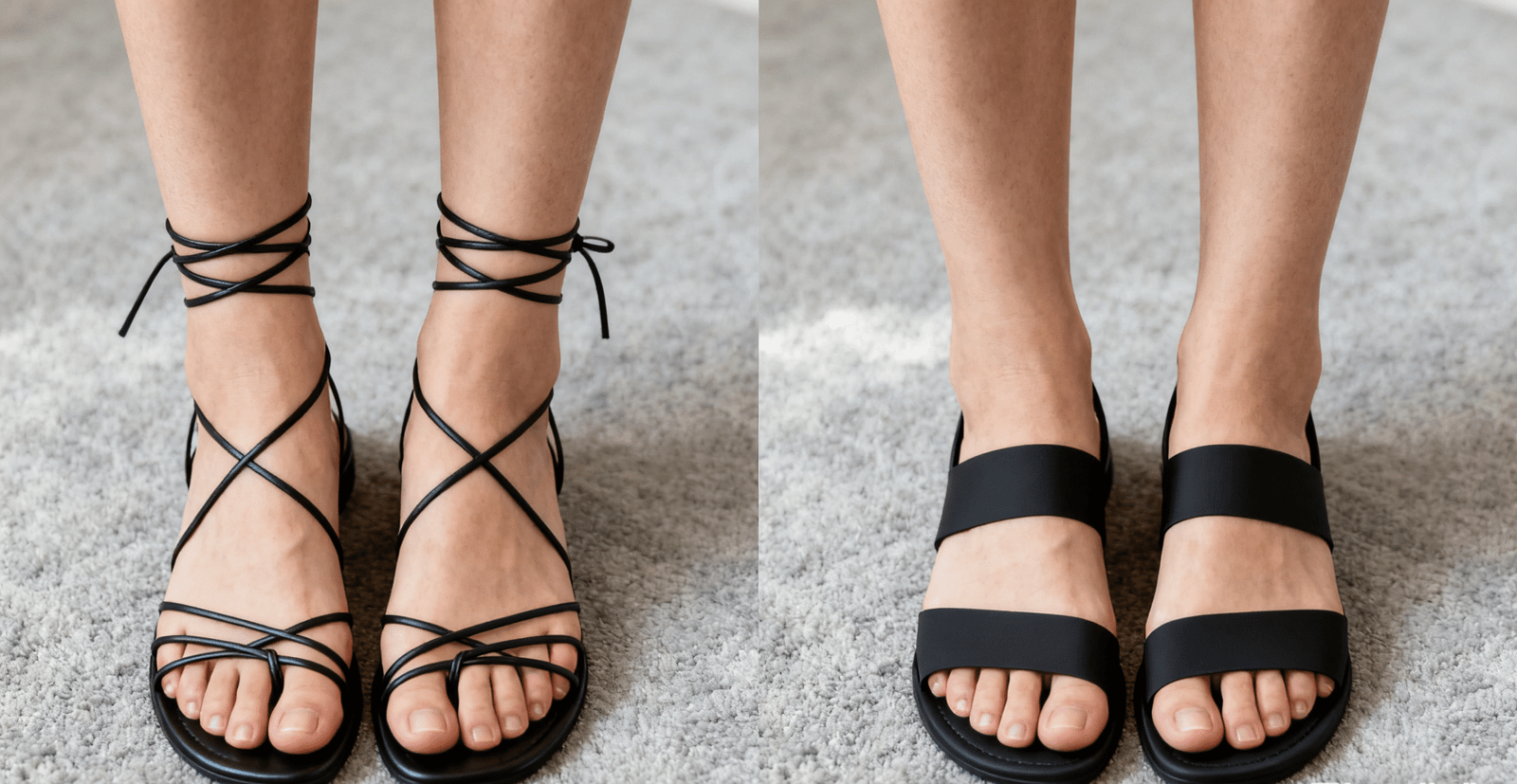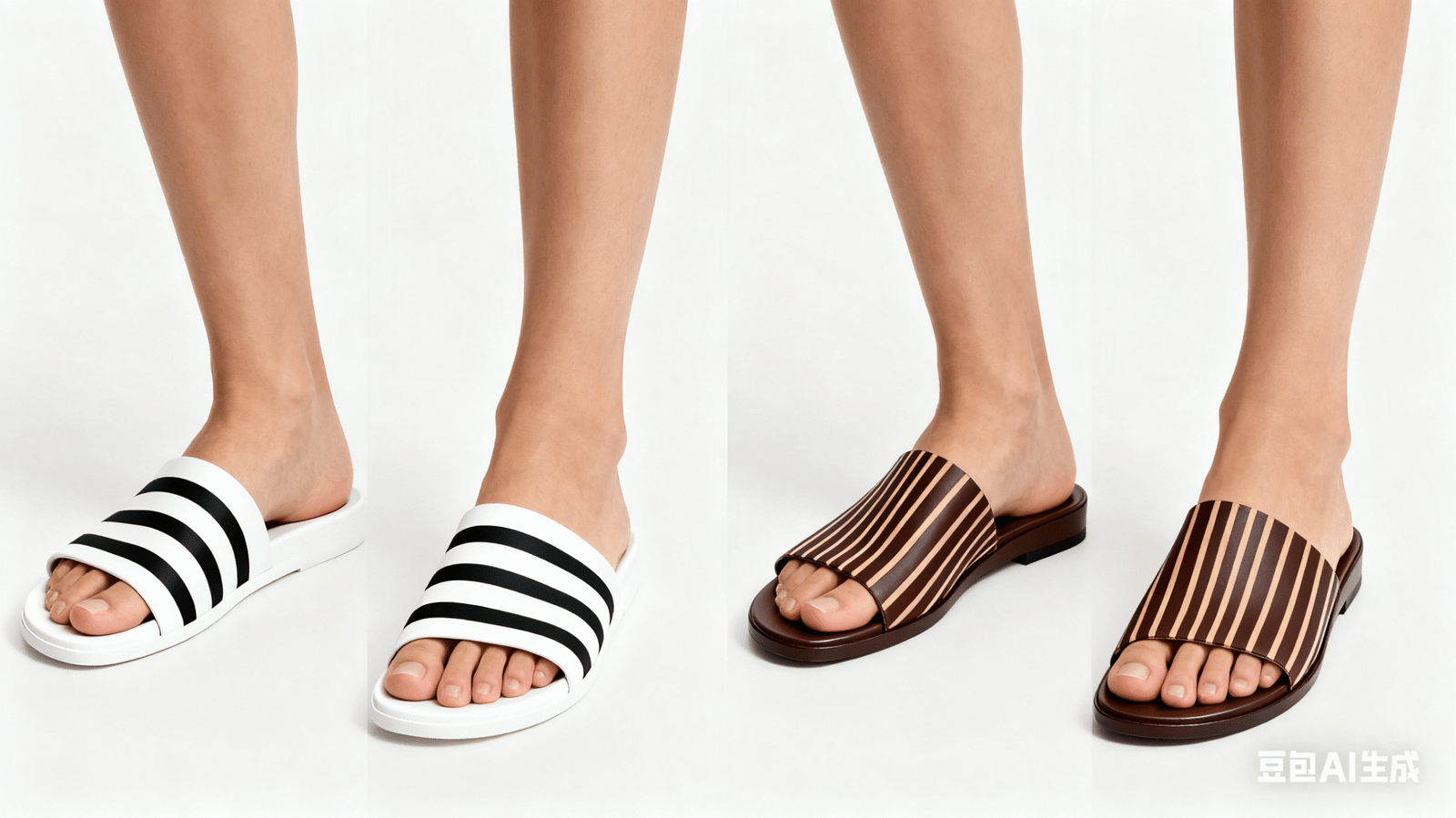How to Pick Sandals That Flatter Wide Feet?
Problem: Do your wide feet make sandal shopping a nightmare? Do you struggle to find stylish options that don't pinch or make your feet look even wider? Agitation: It's frustrating to want to wear cute sandals but feel like you're limited to bulky, unflattering styles that shout "wide feet!" Solution: This guide will help you discover the secrets to choosing sandals that not only fit comfortably but also flatter your wide feet, making them appear narrower and more elegant.
The most flattering sandal shapes for wide feet typically feature open designs, wider straps, and strategic embellishments. Look for styles with adjustable straps, open toes, and a block or wedge heel to provide comfort and create a more balanced look, making your feet appear less wide.
As someone working in the footwear industry since 1998, designing and manufacturing shoes like those we do at Lucas, I've seen countless foot shapes and fashion trends. I understand the challenges many people face when searching for comfortable and stylish shoes, especially sandals for wide feet. It's not just about finding a shoe that fits; it's about finding one that makes you feel good and confident. Today, I want to share some insights from my experience to help you navigate the world of sandals. I believe we can create amazing shoes for everyone.
What Sandal Shapes Are Most Flattering for Wide Feet?
Problem: Do you feel limited by your wide feet when it comes to sandal styles? Are you tired of sandals that make your feet look even bigger or feel uncomfortable? Agitation: It's a common struggle to find sandals that not only fit but also make your wide feet look good. Many styles seem to emphasize width rather than reduce it. Solution: Understanding which sandal shapes are inherently more flattering can transform your summer footwear game, giving you stylish and comfortable options.
The best sandal shapes for wide feet include those with substantial, wide straps, open-toe designs, and often a block or wedge heel. Avoid very thin straps or super-pointy toes, which can make wide feet look squashed and even wider.

When we design shoes at Lucas, we consider various foot types, knowing that true comfort also comes from good aesthetics. For wide feet, certain design elements work better than others. It's about clever design choices that create an illusion of narrowness or simply provide a better, more comfortable fit without compromise.
Are Wide Straps or Thin Straps Better?
When it comes to sandal straps, my experience tells me that wider straps are almost always a better choice for people with wide feet. Thin straps can dig into the foot, creating unflattering bulges and making the foot appear to spill over the sides. Wide straps distribute pressure evenly and can visually reduce width if placed strategically. They offer more support and comfort. Adjustable straps are also important here. They allow for a custom fit, preventing pinching. This also helps accommodate any swelling that happens throughout the day.
Think about a sandal with a wide band crossing the front of your foot. This provides coverage and structure, making your foot look contained and proportional. It's like framing a picture; the frame holds everything neatly.
Do Open or Closed Toes Work Best?
For wide feet, open-toe sandals are generally the superior choice. Closed-toe styles, especially those with pointed or almond-shaped toes, can cramp your toes and make your entire foot look wider and uncomfortable. Open toes allow your feet to spread naturally, which prevents pinching. This also avoids emphasizing width by squishing the foot. If you consider peep-toe styles, make sure the opening is generous. It should not cut across the widest part of your toes.
An open toe allows your foot to breathe and spread out naturally. This natural positioning makes your foot appear more relaxed and proportionate. When your toes are squashed in a closed-toe shoe, the foot looks strained, which can paradoxically make it appear wider.
What Sandal Features Offer the Most Comfort for Wide Feet?
Problem: Are you sacrificing comfort for style when buying sandals because of your wide feet? Do your feet ache after only a short time in "fashionable" sandals? Agitation: It's exhausting to deal with blisters, pinched toes, and general discomfort from ill-fitting sandals, making you dread wearing them even on the warmest days. Solution: Discover key sandal features that prioritize comfort for wide feet, allowing you to enjoy both style and pain-free wear all day long.
For maximum comfort with wide feet, look for sandals with adjustable straps, cushioned insoles, and a wide sole base. Materials that offer some stretch or softness, like leather or certain synthetics, also contribute to a more comfortable fit.

At Lucas, comfort is never an afterthought; it's central to our design philosophy. We know that a comfortable shoe is a shoe that gets worn repeatedly. For wide feet, certain features are non-negotiable if you want to truly enjoy your sandals without discomfort.
Why Are Adjustable Straps Critical?
From years of experience, I can tell you that adjustable straps are absolutely critical for wide feet. Feet can swell throughout the day, and a fixed strap can quickly become tight and uncomfortable. Adjustable straps allow for a personalized fit. They accommodate swelling and prevent pinching. This ensures a secure hold without discomfort. Specific examples include ankle straps with buckles, Velcro closures, or elastic inserts. All these features help give you a truly personalized fit.
Adjustable straps, whether buckles, Velcro, or even elastic gore elements, allow you to customize the fit. This means you can loosen them when your feet swell in the heat or tighten them for a more secure feel. This adaptability is key to all-day comfort.
Do Heel Height and Type Matter?
Absolutely, heel height and type make a big difference for wide feet, both in terms of comfort and visual appeal. I often guide our designers to consider stability when developing heels. Block heels and wedge heels are highly recommended. Block heels give stable support and distribute weight evenly. They also create a balanced look. Wedge heels offer full foot support and elevate without creating pressure points. They also inherently stable. Flat sandals can be comfortable, but they need good arch support and cushioning. Stiletto heels are less stable and concentrate weight on a small area. This can make feet look unbalanced and cause discomfort.
A block heel or a wedge heel offers a much more stable base than a stiletto. This stability is important because it distributes your weight more evenly across your entire foot, rather than concentrating it on the ball of your foot. A stable base will make your foot feel more secure and less likely to spill over the sides, creating a more flattering silhouette.
How Can Styling Tricks Make Wide Feet Look Narrower in Sandals?
Problem: Do you feel that no matter which sandals you pick, your feet still look wider than you'd like? Are you looking for clever ways to create an illusion of narrowness? Agitation: It's disheartening when your efforts to find flattering sandals don't quite hit the mark, leaving you feeling self-conscious about your feet. Solution: Learn simple yet effective styling tricks that can visually slim your wide feet, helping you confidently wear your favorite sandal styles.
Strategic styling can trick the eye, making wide feet appear narrower. Use features like vertical lines, darker colors, and minimal, well-placed embellishments to draw the eye lengthwise and away from width.
In my work, I've learned that fashion is often about illusion. Just as certain clothes can make a body look taller or slimmer, specific shoe designs and styling choices can influence how wide a foot appears. It's not about hiding your feet but presenting them in their best light.
Do Colors and Patterns Play a Role?
Yes, colors and patterns definitely play a role in how wide your feet appear. It’s basic optics. Darker colors tend to recede, while lighter colors and bold patterns draw attention. Opt for solid, darker colors like black, navy, or deep browns. These colors create a visual slimming effect, making your feet appear less broad. Nude shades that match your skin tone can also work wonders. They extend the leg line, which makes your feet seem longer and less wide. Avoid loud, busy patterns or very bright colors on the widest parts of your foot. These can draw attention and make your feet look larger. Also, look for vertical details. A strap going up the center of the foot or T-straps help draw the eye lengthwise. This creates a slimming effect. Avoid horizontal details, as they can emphasize width.
Opt for solid, darker colors like black, navy, or deep browns. These colors create a visual slimming effect, making your feet appear less broad. Nude shades that match your skin tone can also work wonders by extending the leg line, making your feet seem longer and less wide. Avoid loud, busy patterns or very bright colors on the widest parts of your foot, as they can draw attention and make your feet look larger.
Are T-Straps Better Than Ankle Straps?
This is a great question I often get asked. When it comes to T-straps versus horizontal ankle straps, the T-strap generally wins for wide feet. A T-strap creates a vertical line down the foot. This draws the eye lengthwise, making the foot appear narrower. This also elongates the foot and leg, which reduces perceived width. In contrast, a horizontal ankle strap, especially if thick or brightly colored, can cut the leg line. This can make the ankle and foot appear shorter and wider. Any detail that runs lengthwise, like a central seam, helps to slim the foot.
A T-strap forms a vertical line down the center of your foot. This vertical line acts as a visual trick, drawing the eye up and down the foot instead of across its width. This optical illusion makes your foot look longer and, by extension, narrower. In contrast, a thick horizontal ankle strap can cut off the leg line and draw attention directly to the width of the ankle, which can make the foot below it look wider.
In conclusion, choosing sandals for wide feet doesn't mean sacrificing style for comfort. Focus on wide and adjustable straps, open-toe designs, stable block or wedge heels, and strategic styling with darker colors or vertical elements.
